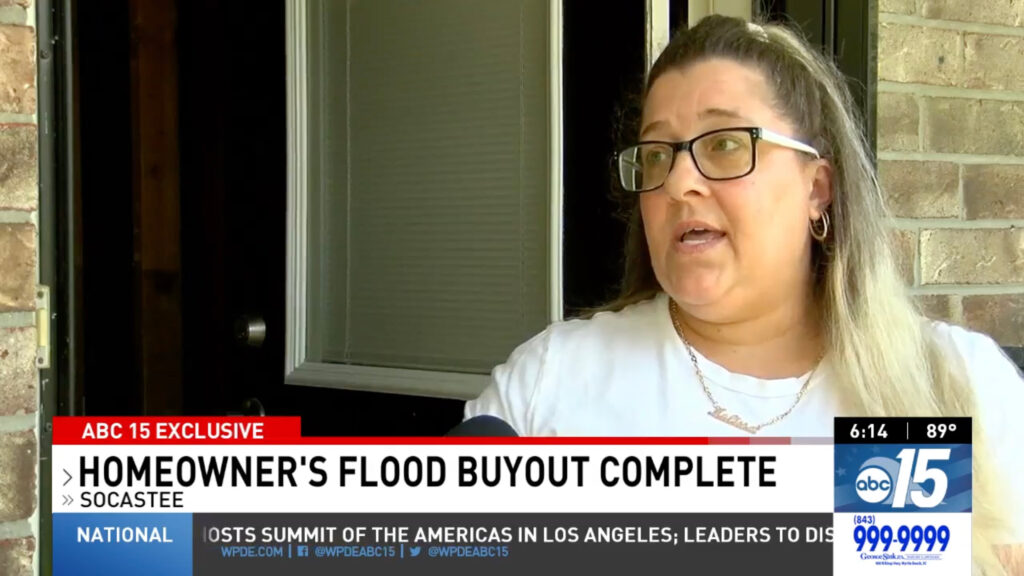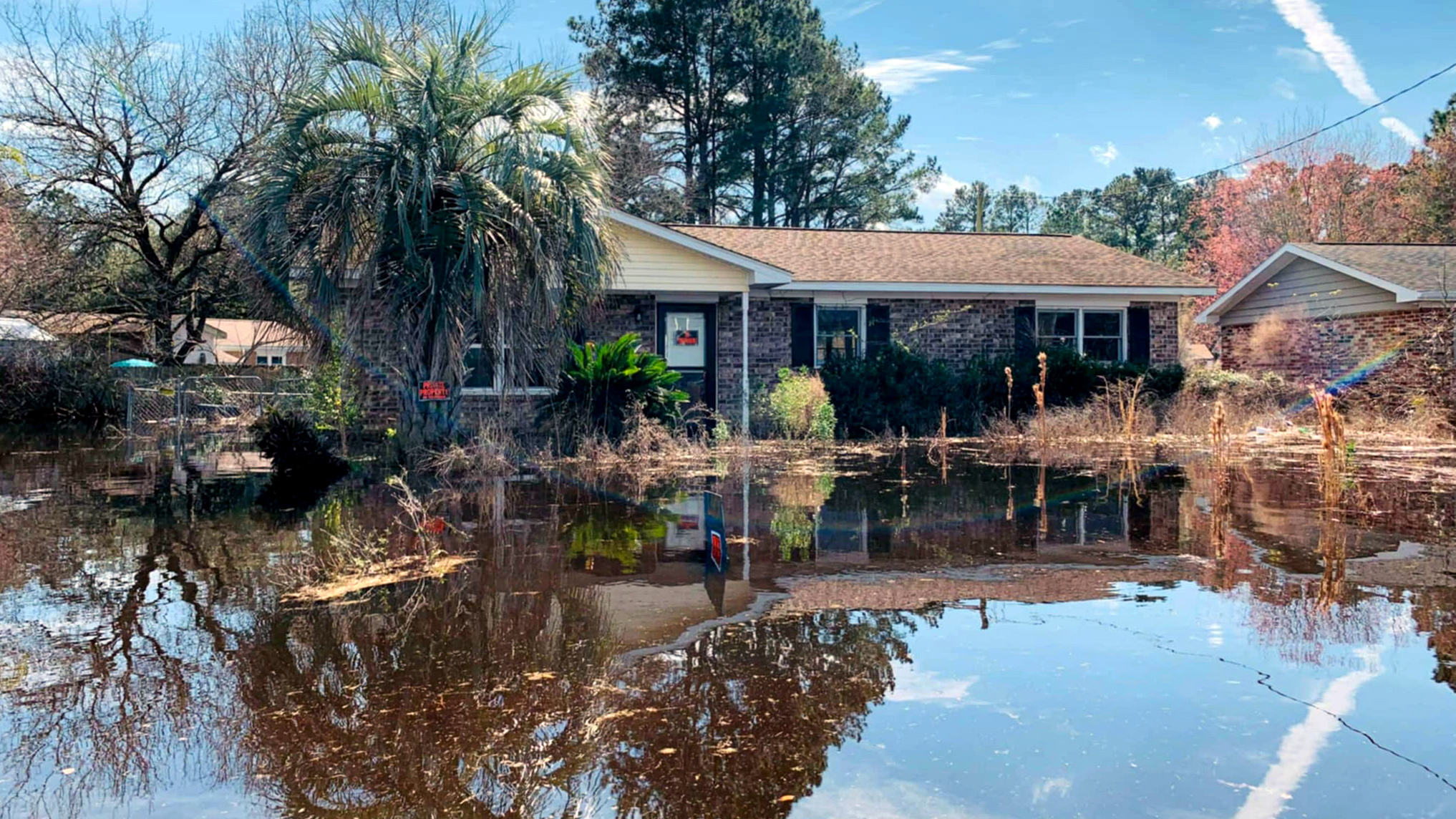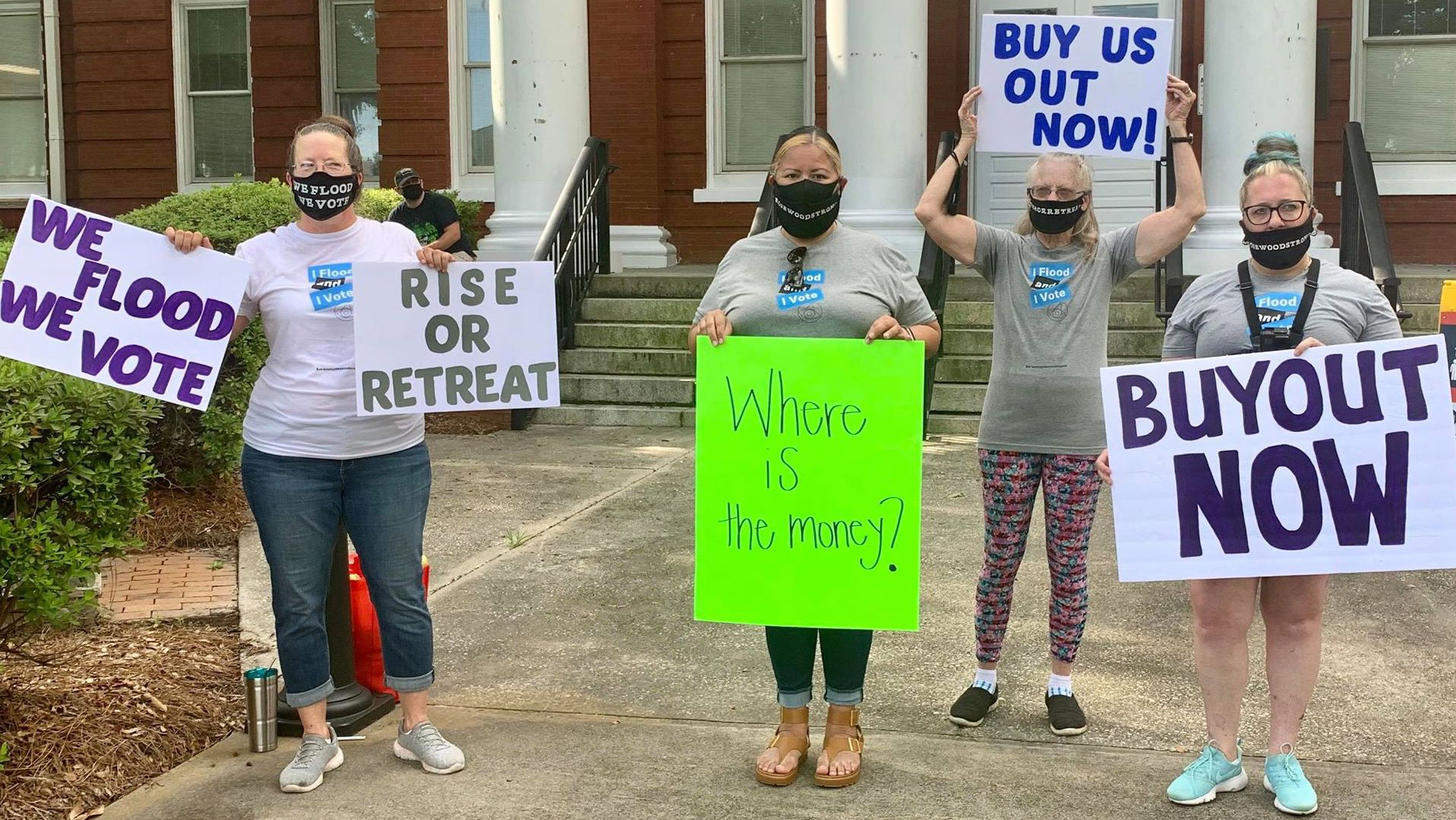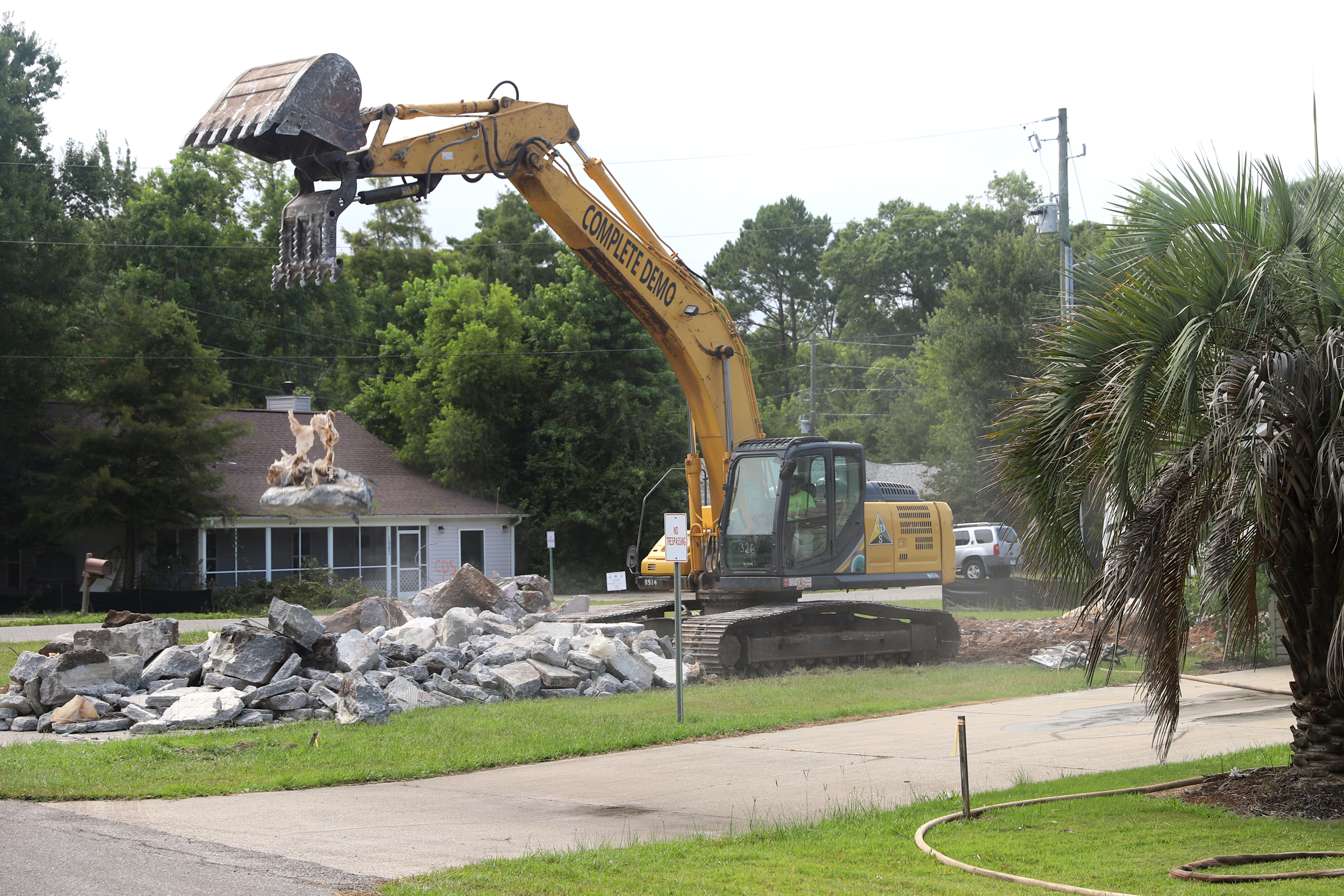South Carolina Is Considered a Model for ‘Managed Retreat’ From Coastal Areas Threatened by Climate Change
Flooding the Market: Second in a series about climate change and coastal threats in South Carolina.
For as long as Melissa Krupa had imagined her dream house, she pictured palm trees in the yard. Krupa, a crisis counselor for victims of domestic abuse, is a self-described “beach girl,” and nothing reminds her of the beach like palms.
In 1996, at 19, she moved from Philadelphia to South Carolina: the Palmetto State with a sabal palm tree on its flag. Seventeen years later she found a brick bungalow in Socastee, a quiet residential neighborhood a few miles from Myrtle Beach. The porch was shaded by three palm trees. A fourth was out back.
Krupa’s new home had its first big flood in 2015. Three years later Hurricane Florence swept five feet of water through her living room. Krupa became the vanguard of a group of locals asking to be bought out: for the state to help them relocate out of harm’s way, and to demolish their homes so that absorbent green space could slow the roll of future flood water for others still living nearby. Krupa had found her dream home, then spent six years begging the government to destroy it. This July, her wish came true.
When she first saw a picture of an excavator perched where her living room used to be, Krupa was devastated. Then, driving past the rubble of her home on a return visit to the neighborhood this August, a new, lighter set of emotions began percolating. “I’m free,” she said, “free from the stress and worry of having to sell that home and put somebody else in that situation.” Because while Krupa and some neighbors waited years after Florence for a buyout, others sold their properties to real estate agents in the meantime—to rent or sell again, advocates say, without properly warning new residents about the neighborhood’s repeat flood risk.

South Carolina is ahead of the curve when it comes to planning for “managed retreat”: the idea that people living in climate-vulnerable places will need support to gradually leave. The state has a climate resiliency office which already acknowledges hundreds of thousands of homeowners will need to relocate away from the coast, abandoning their current houses for demolition. But managed retreats can only happen voluntarily and in Socastee, less than one in 10 eligible owners signed up.
Some just didn’t want to leave their homes. But advocates say the process, for all its success, had flaws. In the years it took to secure and organize a buyout, many owners sold their homes to real estate agents and left. Instead of joining the buyout, advocates say some of those agents quickly sold or rented the same properties to newcomers, claiming that South Carolina’s flood disclosure rules only required them to warn about floods during their brief ownership.
“From 2015 to today I’ve watched people again and again sell their house because they have no other choice,” said Krupa, who moved back to Pennsylvania after Hurricane Florence, but keeps in touch with her old neighbors. “They would give it to a flipper, and I would watch the house get flipped. And then I watched new people come in. It’s not fair. If you think about it, it’s disgusting.”
Lightning in a Bottle
South Carolina is one of very few red states with a dedicated climate resilience office and a resiliency plan for adapting to climate change. While in many parts of the country the idea of managed retreat is still taboo, in June 2023 the South Carolina Office of Resilience (SCOR) published a resilience plan estimating that 700,000 flood-prone houses will have to be torn down, and mapping where those areas are along the coast. That makes South Carolina a role model for other states, according to Mathew Sanders, an analyst with the policy research nonprofit Pew Charitable Trusts focusing on disaster resilience.
SCOR is “taking the issue seriously, and they’re looking at it with a degree of sobriety that maybe other places have not,” said Sanders, who previously led the creation of a $93-million, Obama administration resiliency plan for Louisiana which includes extensive managed retreat planning. “Through this matrix”—a system which prioritizes parts of South Carolina by climate risk alongside factors like race and income—“they’ve highlighted considerable areas within the state in which they intend to conduct buyout activities. Nobody has really tried to put all those pieces together in the way South Carolina has.”
Explore the latest news about what’s at stake for the climate during this election season.
Identifying flood prone areas to buy out in South Carolina is not as simple as casting your eyes along the coast, or even pulling up a floodplain map. When Hurricane Debby struck the state in August, for example, 78 percent of damaged houses were outside federally designated flood zones, according to mapping analysis.
Socastee is the same: Krupa’s old house was five miles inland and the neighborhood was only designated a floodplain in 2023 after years of repeated flooding. Instead, Socastee is vulnerable because it backs onto a manmade section of the Atlantic Intracoastal Waterway: a 3000-mile shipping channel running inland parallel to the coast from Massachusetts, around Florida and on to Texas.
Locals say flooding started to become a regular issue in some homes in the early 2010s, then deluges swept through Socastee in 2015 and 2018. Now large parts of Socastee can flood on a rainy day. The change has been driven by climate change in two ways. First, as the air warms it can hold more moisture and drop huge so-called “rain bombs” where precipitation might once have been dispersed over a number of lighter storms. Second, as sea levels rise, groundwater along the coast of South Carolina is becoming rapidly more saturated. So when rainfall comes, the ground can absorb less water before it begins to flood through homes.

The trick to an effective buyout, Sanders said, is to strike while the iron is hot after a bad flood. “As more time passes, people start to talk themselves into the notion that this [flood] was a once in a lifetime thing.” So the best buyouts—Sanders lists programs from the Mississippi River floodplain in Illinois to Charlotte, North Carolina—offer vulnerable communities cash to move as soon as possible after a flood. “They were able to catch lightning in a bottle,” Sanders said. “But it’s really hard: It requires a degree of luck. You have to have all these ingredients in the right place at the right time.”
More often, as in Socastee, it can take years to plan and secure the funding to pay homeowners fair market value for their homes. “So the incentives are misaligned, right, because the funding is usually not there at the moment that there’s most desire for a buyout. And when there’s the most desire for a buyout, the pre-planning has typically not taken place.”
“Those people who might have been hanging on for a buyout, just gave up, and all the homes that had flooded: Developers were buying them out cheap and flipping them.”
While Sanders is optimistic the state’s new resilience plan will help streamline the next buyout, it came too late for Socastee. Krupa uses the language of battle to describe years of fighting: first for a buyout to happen at all, then for the state to offer enough money. For advocates like Harriet Festing, the director of a national coalition of 350 frontline communities called Anthropocene Alliance, it often felt more “like a poker game.”
“We had a timespan where things were moving quite quickly, then everything got stuck,” said Festing, who connected with Krupa through Facebook in 2018 when Anthropocene Alliance was only 40 groups strong. “The whole process of setting up the program took forever, then they weren’t offering enough money and everything. So those people who might have been hanging on for a buyout, just gave up, and all the homes that had flooded: Developers were buying them out cheap and flipping them.
“I think that was the point where this feeling of greatest despair [arrived]: You had your hope; you felt as though the money might be flowing,” she said. “And then it just got caught up.”
A More Detailed Story
Officials with SCOR, the state’s resiliency office, declined to be interviewed but said in written responses to Inside Climate News that they judged the program to be generally effective. “The success of the Socastee buyout program is a shared success for SCOR, Horry County, and the citizens of the Socastee area. … Beyond moving citizens out of harm’s way, properties in our buyout program are deed restricted and held in perpetuity as greenspace. Property owners that do not participate in the voluntary buyout program will also benefit from the added greenspace to absorb water,” a spokesperson wrote, acknowledging that some homeowners wanted to stay in Socastee, and that a post-COVID bump in housing prices made relocating difficult for some.
County property records tell a more detailed story about the buyout. For some homes, often where deeds have passed between family members since the neighborhood was built in the 1980s, owners did choose to stay. In many others, however, locals sold in the years after Hurricane Florence while Krupa and Festing were fighting for a buyout program. Often that meant owners who could not afford to wait lost tens of thousands of dollars, while their houses continue to stand in harm’s way.
One home, now sandwiched between two lots that were cleared in the buyout, was sold at the end of 2020 for less than the owners bought it for in the 1990s, and flipped three weeks later. Another owner in a run of now demolished houses sold their home to a realtor for just $40,000 while the buyout was being planned. Legacy Builders SC sold the house five months later for $145,000, while the neighbors were eventually given buyouts averaging more than $250,000.
As well as appearing to punish owners who couldn’t afford to stay in flood-prone homes waiting for a buyout, the sale of some homes creates a kind of “checkerboard” retreat, according to Sanders. Leaving some properties standing while others are demolished fundamentally undermines one of the aims of a buyout, which is to return an area to more absorbent greenspace in order to protect the next line of buildings from future flood water for longer.

Dozens of other homes are now still owned by real estate companies which locals say rent the houses out, some allegedly without warning people who move in.
According to Festing, Krupa and other locals, shifting property between different owners could be a way to avoid telling new tenants or owners about flood risk under recent updates to real estate disclosure law in South Carolina. There is no national standard for warning new owners about a property’s flood history when they buy it. At the time that Hurricane Florence hit South Carolina in 2018, for example, the state did have a mandated disclosure form, but advocates had long complained that questions about flooding were too broad to constitute a genuine warning for buyers.
Where the form required written descriptions of a property’s history with issues such as bug infestations or dry rot, it only included checkboxes about “problems caused by fire, smoke, or water” and “flood hazards” and current “flood insurance.” In practice, these were sufficiently vague for a new owner to purchase a property without knowing if it had actually flooded. A question specifically about flooding was added to South Carolina’s form in 2019, but buyers were still not warned about how recent, severe or frequent past flooding was.
By contrast, Texas and Louisiana began requiring sellers to disclose how much insurance money or federal disaster aid previous owners had received after facing hurricanes Harvey and Katrina respectively.
In June 2023, South Carolina’s regulators updated the state’s disclosure form, citing pressure from the Southern Environmental Law Center (SELC) and a series of articles by the Charleston-based Post and Courier newspaper. The new form requires sellers to list flood insurance claims and the cost of flood repairs during their ownership, and check a box acknowledging “flood risk.” The changes were enough to earn South Carolina a remark on the Natural Resources Defense Council’s state-by-state scorecard for flood disclosure regulations: up two grades from a “C” to an “A”.
Still, negotiating the changes entailed some concessions to an industry lobbying group, the South Carolina Realtors, according to Jenny Brennan, a policy analyst with SELC who pushed for the 2023 changes. “A couple of things that were a little more specific got left on the table,” which could help specifically warn potential buyers, Brennan said, like questions about past emergency orders, or if the property is on a floodplain. “It is much better than no transparency and no sharing of information,” she added—currently the standard in over a third of states, seven of them coastal—“but it’s not a perfect fit and it isn’t a perfect solution.”
The form asks sellers to acknowledge “actual knowledge” of risks: wording designed to recuse owners from an impractical amount of research into damage before their ownership. But that could pose a practical problem, Brennan said, in certain cases. “What if that flood was 10 years ago, or 12 years ago and the house has been sold three times since?” Brennan said. “You’re not necessarily going to know as a third owner.”
One home in Socastee was sold in 2020, passed through three different realtors (including one that was sued for not disclosing toxic mold in a Utah house) before being sold to a new owner. Another owner moved to Socastee just months before Florence struck; after the hurricane they promptly sold their property to a company called Down Home Investments, that then transferred the deed to the company’s owners, before it was dissolved. The deed was then transferred to a company with the same owners called DHI Holdings, which sold it to new residents who left Socastee within two years.
Michael Collins co-owned both companies and said he switched the deed to avoid tax, not flood disclosure. He acknowledged that changing ownership to avoid sharing a full flood history “is a loophole someone might be able to use, but I go to the side of honesty and integrity.” Collins said he did not detail flood repairs or history in his disclosure form but that the property listing voluntarily described how the house had flooded during Hurricane Florence but not Hurricane Matthew in 2015, and that new owners would require flood insurance. “There are risks that come with living on the river … somebody that maybe just moved to the area might not be aware of it but they’re going to find out.”
Asked about whether real estate companies that purchased and then quickly sold properties had undermined the buyout, SCOR’s representative wrote: “We do not have enough information to offer insights on the frequency of these instances, or their effect on buyout program participation.” Brennan had not heard of the type of fast-paced flipping of flood-prone homes Festing, Krupa and other locals described in Socastee, but encouraged anyone who had purchased a home in a buyout area without warning to consider reporting their seller to the state’s Real Estate Commission for investigation.
If a home was not flooded during a realtor’s brief ownership and the previous owner completed all flood repairs before selling it, then the new owner might accurately fill out most of the new form with no evidence of flooding. It still would not be credible for an owner to report no “actual knowledge” of “flood risk,” Brennan said, in a neighborhood where neighbors routinely move their cars to highground if heavy rain is forecast. However a realtor might try to justify it, selling a house in Socastee without warning about flooding at all “directly runs afoul of the disclosure requirement” and is “really deeply concerning,” said Brennan.
“There could be a situation where if truly the repairs had happened before the purchase, you could try to claim that you didn’t have awareness [of flooding] but if that entire community is going through the buyout process, it is going to be very difficult to not be aware,” Brennan said. “All of your neighbors are going to be talking about it, the community, the city is going to be talking about it.”
The South Carolina Realtors did not respond to a request for comment. A spokesperson for the South Carolina Real Estate Commision, an elected group that regulates the industry, confirmed the disclosure form was most recently updated last summer, but did not comment on advocates’ concerns.
Closing on a Home
Advocates and locals hope the Socastee buyout might offer lessons for other risky areas in Horry County, which borders North Carolina along the coast, and the state at large. SCOR is stewarding 10 other buyouts, according to its vulnerability matrix, with half already returned to greenspace. Meanwhile Brennan is working with state officials to design an online tool where potential buyers could search some of a property’s flood risks which aren’t obscured by privacy laws (such as past emergency orders on a neighborhood to neighborhood level).
Even the bulldozers moving into Socastee were a kind of proof that buyouts work. According to SCOR, the start of demolitions in July “sparked more interest in program participation,” despite applications having closed. For Sanders, that stands to be the next test of managing the state’s retreat from an increasingly risky coastline. “The key for South Carolina is going to be the durability of the program,” he said. “Make sure that the outcomes for the folks that are participating can be illustrative to the rest of the community.”

For some more skeptical homeowners in Socastee, the physical evidence of a demolished house was the first proof the buyout would happen at all. When Krupa talks about denialism, she is referring both to neighbors who didn’t believe climate change was driving worse flooding, and others who didn’t believe in the buyout itself.
Krupa’s outcome still feels bittersweet, even if her home’s demolition offers a kind of closure. “It’s like a loss, but I look at it from a different perspective now,” she said. “There’s sort of a joy in it too: I go back and I look and it’s beautiful land and I’m ok. The memories are set there forever now. So it’s ok. I guess part of the healing is you go through it, you’re done, you get out. But you kind of have to still stay in it because it was such an experience.”
One thing does pull Krupa back to memories of her dream house a little more than she’d like: she still gets calls from realtors, asking if she would consider selling. She laughs now, though, because all that’s left to sell are four palm trees.
About This Story
Perhaps you noticed: This story, like all the news we publish, is free to read. That’s because Inside Climate News is a 501c3 nonprofit organization. We do not charge a subscription fee, lock our news behind a paywall, or clutter our website with ads. We make our news on climate and the environment freely available to you and anyone who wants it.
That’s not all. We also share our news for free with scores of other media organizations around the country. Many of them can’t afford to do environmental journalism of their own. We’ve built bureaus from coast to coast to report local stories, collaborate with local newsrooms and co-publish articles so that this vital work is shared as widely as possible.
Two of us launched ICN in 2007. Six years later we earned a Pulitzer Prize for National Reporting, and now we run the oldest and largest dedicated climate newsroom in the nation. We tell the story in all its complexity. We hold polluters accountable. We expose environmental injustice. We debunk misinformation. We scrutinize solutions and inspire action.
Donations from readers like you fund every aspect of what we do. If you don’t already, will you support our ongoing work, our reporting on the biggest crisis facing our planet, and help us reach even more readers in more places?
Please take a moment to make a tax-deductible donation. Every one of them makes a difference.
Thank you,
David Sassoon
Founder and Publisher
Vernon Loeb
Executive Editor
Share this article
Disclaimer: The copyright of this article belongs to the original author. Reposting this article is solely for the purpose of information dissemination and does not constitute any investment advice. If there is any infringement, please contact us immediately. We will make corrections or deletions as necessary. Thank you.
Title:South Carolina Is Considered a Model for ‘Managed Retreat’ From Coastal Areas Threatened by Climate Change
Url:https://www.investsfocus.com








